Key takeaways:
- Isolation during Covid heightened feelings of anxiety and loneliness, emphasizing the necessity of reaching out for genuine connection.
- Building connections through shared experiences and empathetic communication fosters resilience and mental wellbeing.
- Personalized outreach and active listening are effective strategies for identifying and supporting isolated individuals.
- Long-term relationships formed during isolation can enhance emotional support, creativity, and opportunities for personal growth.
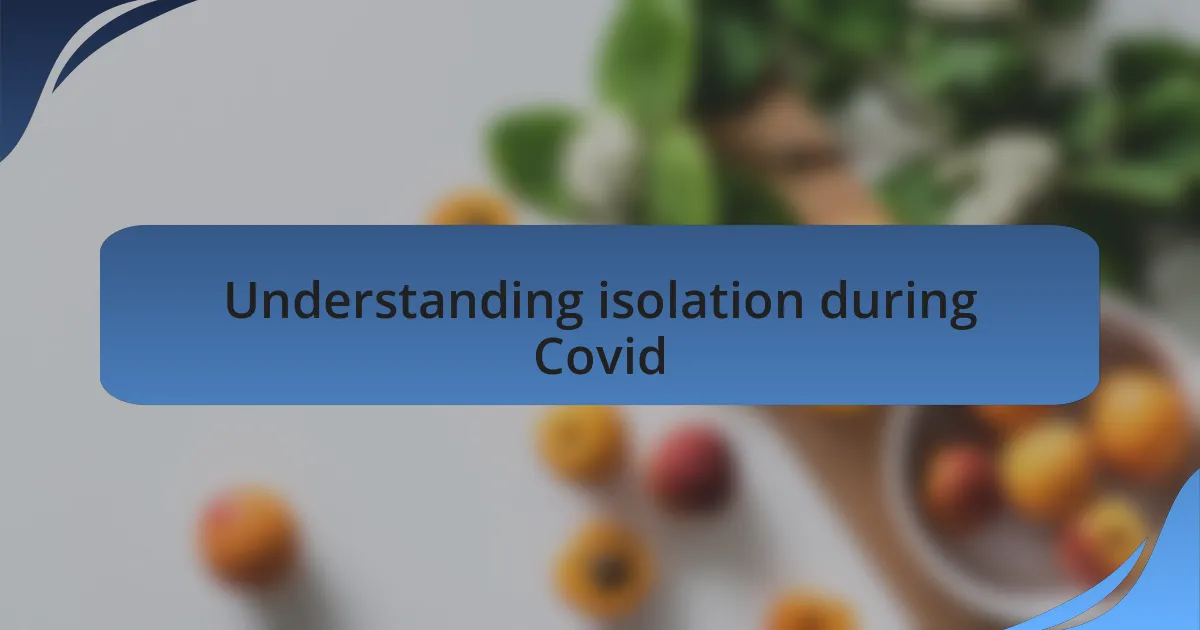
Understanding isolation during Covid
Isolation during Covid has taken on a whole new meaning for many of us. I remember days when the silence of my own home felt overwhelming, leaving me to grapple with feelings I hadn’t fully acknowledged before. Have you ever felt that haunting loneliness when you’re physically surrounded by nothing but your thoughts?
The stark reality is that isolation can exacerbate feelings of anxiety and depression. I recall speaking with a neighbor who described her experience of isolation as if she were trapped in a fog—surrounded by people online yet feeling more disconnected than ever. It made me wonder, how many of us are silently yearning for genuine connection, but unsure of how to reach out?
Navigating this new landscape means understanding that isolation affects everyone differently. For me, it sparked a deep sense of empathy towards friends who had fallen off the radar. I often found myself asking, how can we truly support one another when the very act of reaching out feels monumental? In these moments, I realized that even a simple message can bridge the gap, reminding us we’re not as alone as we might think.
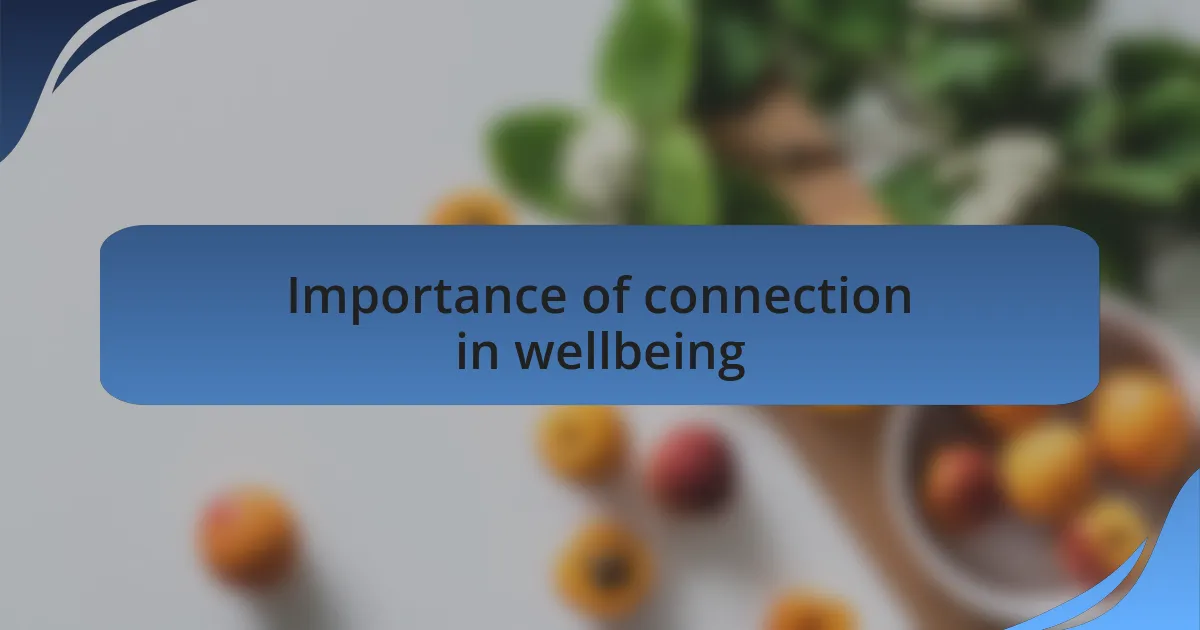
Importance of connection in wellbeing
Connection plays a crucial role in our overall wellbeing. I recall a phone call with an old friend during the height of isolation. Hearing her voice, filled with warmth and nostalgia, washed away some of the loneliness I’d been feeling. It struck me how simply sharing our experiences became a lifeline, transforming our mutual sense of isolation into a shared journey.
The truth is, when we connect, we validate each other’s feelings. Have you noticed how a heartfelt conversation can change your perspective? I remember surprising myself with laughter during a video call, even on days when I felt heavy-hearted. Those moments taught me that connection isn’t just about sharing joys; it’s about acknowledging struggles too, reminding us we’re part of something larger than ourselves.
Moreover, these connections can foster resilience. Remembering how my community rallied together for virtual game nights made me feel a sense of belonging I desperately craved. It’s fascinating how even through a screen, the sense of togetherness created a buffer against anxiety, proving that our mental health thrives on genuine interactions, no matter the distance.
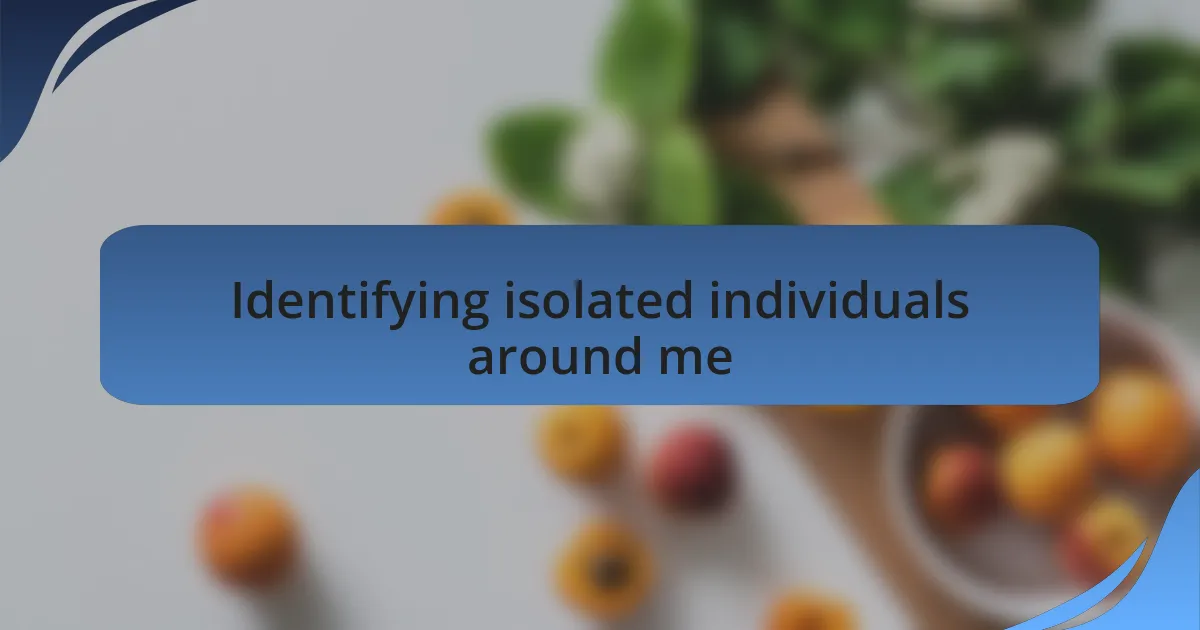
Identifying isolated individuals around me
Identifying isolated individuals around me first required me to look beyond the usual faces I interacted with daily. I remember noticing an elderly neighbor who had always been cheerful suddenly stopped greeting me during my morning walks. It made me wonder: was she okay? Subtle changes in routines or social behaviors can be indicators of someone feeling isolated or struggling, and I realized it was important to trust those instincts.
Another instance was with a colleague who typically joined our lunch group but had been absent for weeks. I decided to reach out to her via a simple message, just to check in. It turned out she was feeling overwhelmed and disconnected. This experience reinforced my belief that taking the initiative to engage with people can uncover hidden struggles, even among those who seem to manage well on the surface.
In my community, I also found that volunteering became a way of spotting individuals who might be feeling alone. During a food drive, I met several people who shared their stories, revealing feelings of loneliness despite being surrounded by others. Have you ever realized that those needing connection can sometimes be found in places you least expect? Engaging in community activities opened my eyes to the depth of isolation many experience, and it encouraged me to create more opportunities for connection.
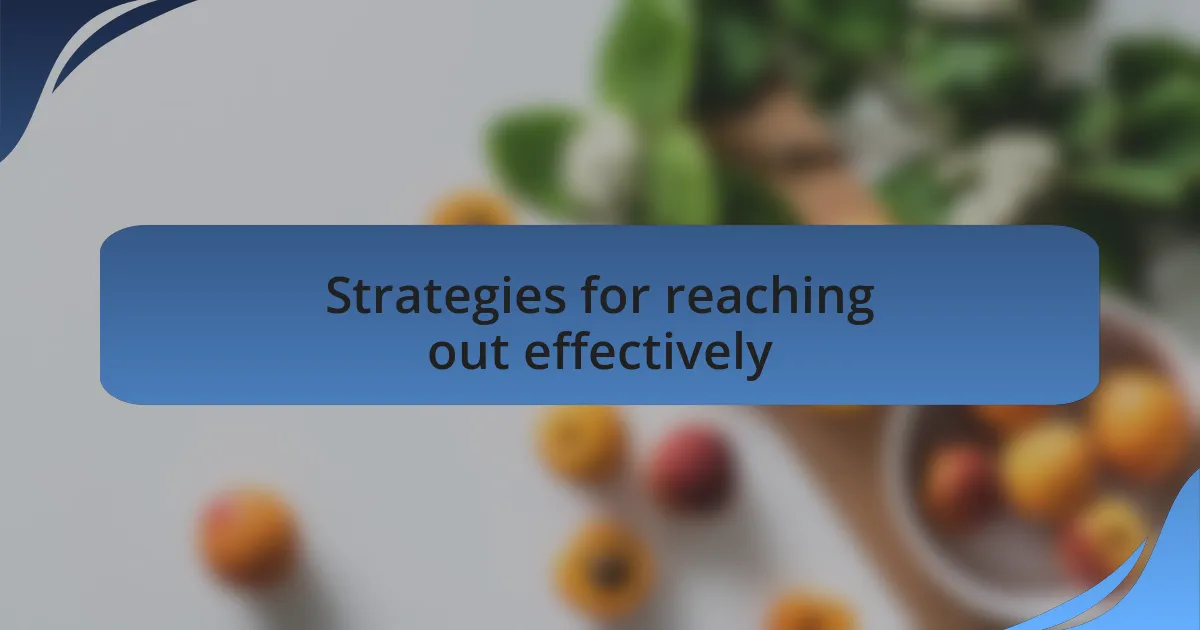
Strategies for reaching out effectively
One effective strategy I found invaluable is personalizing my outreach. Early on, I reached out to a friend who had been quiet on social media. Instead of sending a generic text, I reminded her of an inside joke we shared. The moment she saw that familiar reference, I felt her warmth through the screen. It sparked a genuine conversation. Don’t you think those little tailored details can show someone you truly care?
Another approach was the power of listening—really listening. When I chatted with my neighbor, I made it a point to ask open-ended questions about her garden, something she loved. I encouraged her to share her feelings about the changes in her daily life, and that simple act of being present allowed her to open up about her isolation. Hasn’t someone just listening made a big difference for you too?
Lastly, I found that creating virtual gatherings fostered a deeper level of connection. I initiated a weekly coffee chat via video call for a small group of friends. The informal setting took away pressure, letting everyone freely share their experiences. This not only brought us closer, but it also helped individuals feel seen and valued. Do you remember a time when group conversations helped lift your spirits?
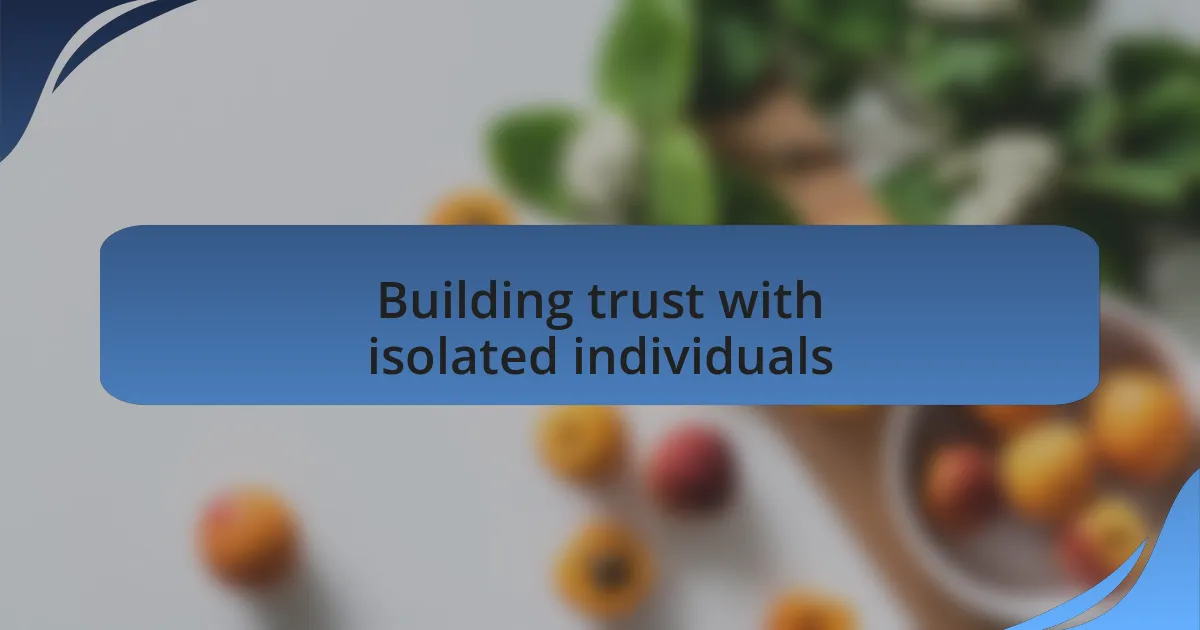
Building trust with isolated individuals
Building trust with isolated individuals requires a genuine commitment to understanding their feelings. I recall a time when a colleague opened up about her struggles with loneliness during the pandemic. It was the first time I had really seen her vulnerability. By simply acknowledging her experience without judgment, I felt trust bloom between us. Have you ever noticed how offering a space for someone to share can create an unspoken bond?
Employing empathy is another crucial element in this process. One evening, I had a chat with a family member who felt disconnected from everyone. Instead of rushing to offer solutions, I took the time to reflect on how overwhelming isolation can be. By expressing that I understood her feelings, I could see her visibly relax. Isn’t it remarkable how empathy can validate someone’s experience and strengthen trust?
Finally, consistency plays a vital role in earning trust over time. I made a habit of checking in weekly with a friend who was having a tough time. These small, regular gestures showed her that I was genuinely invested in her wellbeing. Eventually, she started sharing more deeply, revealing layers of her life she had initially kept hidden. Isn’t that a powerful reminder of how steadfast support nurtures trust?
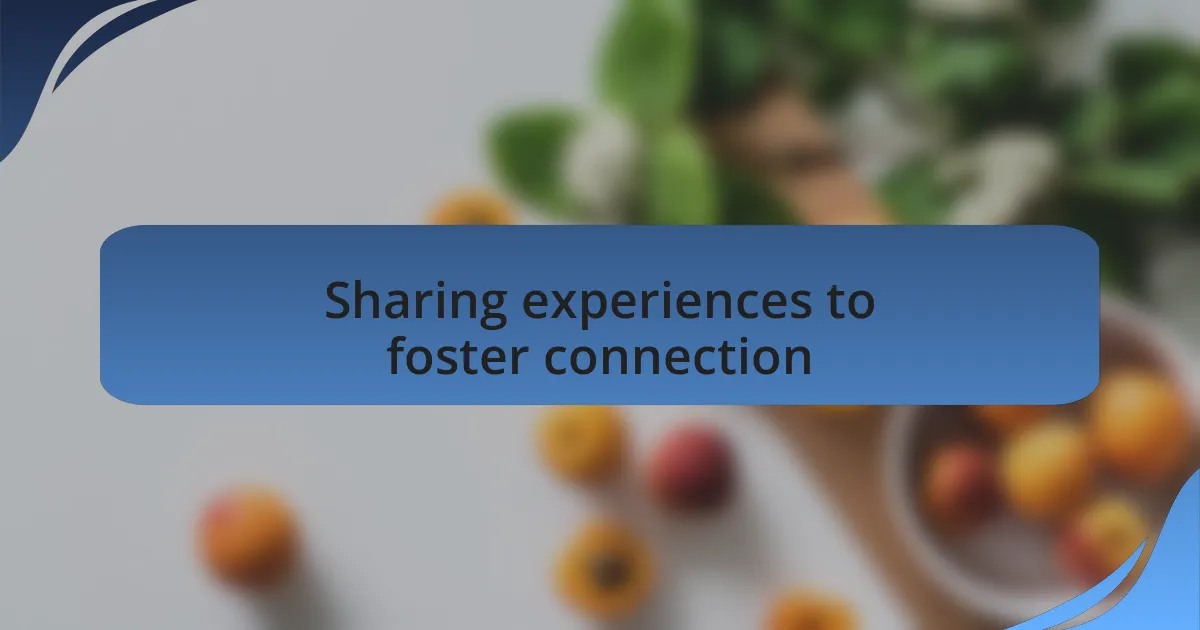
Sharing experiences to foster connection
Sharing experiences has a unique power to create connections, especially during times of distress. I remember hosting a small virtual gathering where participants shared their personal stories related to isolation. As each person spoke, I noticed how laughter emerged even amongst tears. It became clear that our shared vulnerabilities forged an instant bond. Have you ever felt how communal storytelling can transform a lonely experience into a collective journey?
When I opened up about my own challenges with isolation, it surprisingly invited others to share their struggles too. I had a friend who typically kept her feelings private. However, once I shared my story about grappling with anxiety, she opened up about her sleepless nights and fears of the future. I couldn’t help but feel a sense of relief wash over both of us. Isn’t it incredible how our willingness to be vulnerable can create a safe space for others?
One memorable episode was when I organized a ‘story swap’ with a group of acquaintances. Each person was tasked with sharing a moment of vulnerability—not an easy feat for many. Yet, as we exchanged these poignant narratives, I could sense a remarkable shift in the room. By the end, it felt like we had woven an invisible thread of connection that would linger long after the meeting ended. How often do we underestimate the power of simply sharing our experiences with one another?
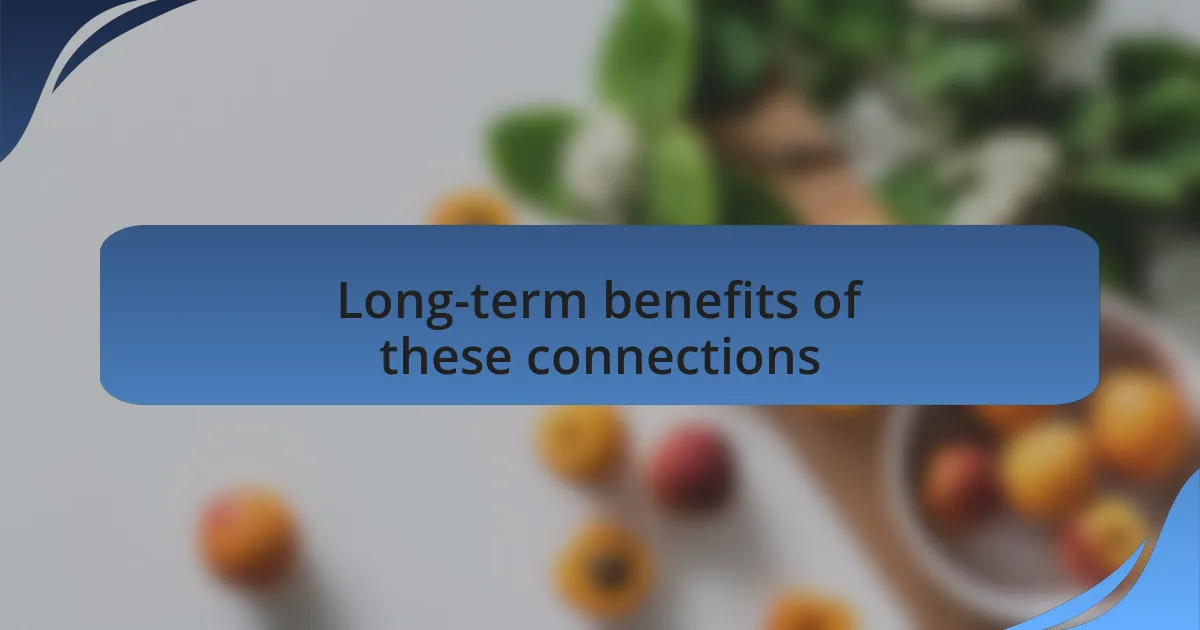
Long-term benefits of these connections
Building connections with isolated individuals can lead to profound long-term benefits, impacting mental and emotional health. I recall a chat with a former colleague who had felt cut off from the world during lockdowns. Months later, he told me that the friendships he forged through online meetups had become his lifeline, bringing laughter and a sense of community. Isn’t it amazing how these renewed connections can uplift our spirits long after the moment has passed?
Over time, I found that these relationships often lead to deeper emotional support networks. One of my closest friends started reaching out regularly, sharing tips on coping strategies for anxiety. As we leaned on each other, I realized we were both developing resilience together. How often do we discover that true growth emerges from leaning into relationships built during tough times?
Additionally, the bonds formed through shared experiences can lead to increased opportunities for collaboration and creativity. I participated in a project with some of the people I connected with during online gatherings, which later blossomed into a new hobby. What started as a response to isolation evolved into something enriching, showing me that these relationships could spark new passions in unexpected ways. How do you think your own connections might lead you to new paths of discovery?